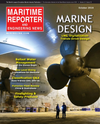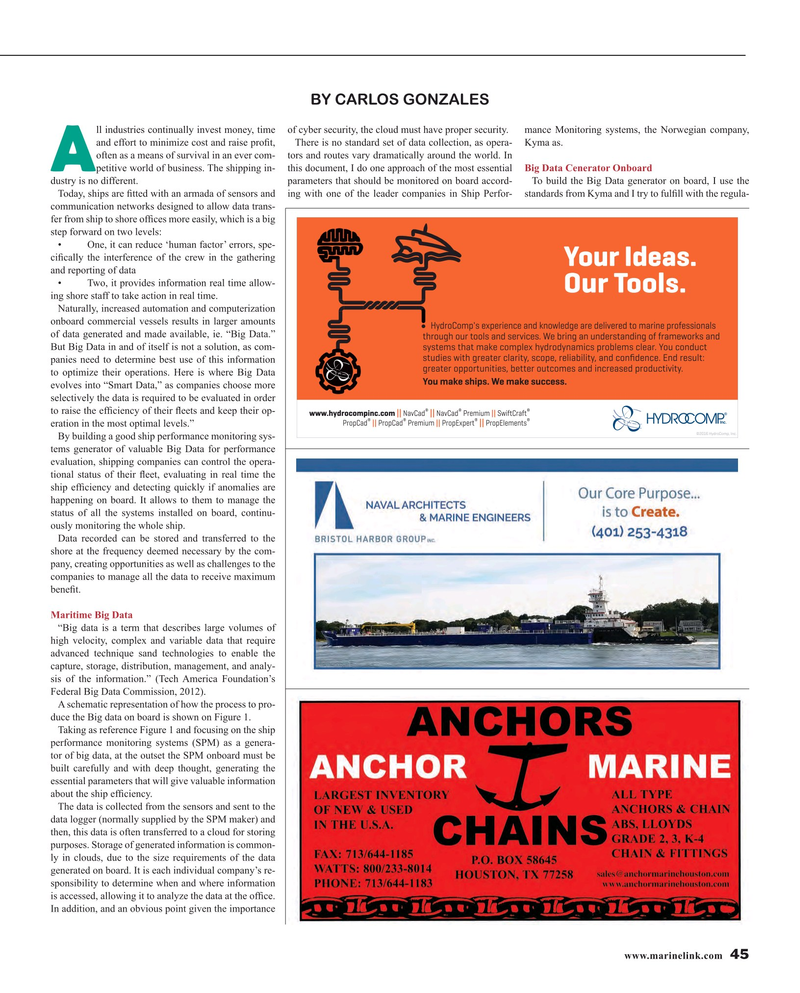
Page 45: of Maritime Reporter Magazine (October 2016)
Marine Design Annual
Read this page in Pdf, Flash or Html5 edition of October 2016 Maritime Reporter Magazine
BY CARLOS GONZALES ll industries continually invest money, time of cyber security, the cloud must have proper security. mance Monitoring systems, the Norwegian company, and effort to minimize cost and raise pro? t, There is no standard set of data collection, as opera- Kyma as.
often as a means of survival in an ever com- tors and routes vary dramatically around the world. In
Apetitive world of business. The shipping in- this document, I do one approach of the most essential Big Data Cenerator Onboard dustry is no different. parameters that should be monitored on board accord- To build the Big Data generator on board, I use the
Today, ships are ? tted with an armada of sensors and ing with one of the leader companies in Ship Perfor- standards from Kyma and I try to ful? ll with the regula- communication networks designed to allow data trans- fer from ship to shore of? ces more easily, which is a big step forward on two levels: • One, it can reduce ‘human factor’ errors, spe- ci? cally the interference of the crew in the gathering
Your Ideas.
and reporting of data • Two, it provides information real time allow-
Our Tools.
ing shore staff to take action in real time.
Naturally, increased automation and computerization onboard commercial vessels results in larger amounts HydroComp's experience and knowledge are delivered to marine professionals of data generated and made available, ie. “Big Data.” through our tools and services. We bring an understanding of frameworks and
But Big Data in and of itself is not a solution, as com- systems that make complex hydrodynamics problems clear. You conduct studies with greater clarity, scope, reliability, and con?dence. End result: panies need to determine best use of this information greater opportunities, better outcomes and increased productivity.
to optimize their operations. Here is where Big Data
You make ships. We make success.
evolves into “Smart Data,” as companies choose more selectively the data is required to be evaluated in order ® ® ® to raise the ef? ciency of their ? eets and keep their op- NavCad NavCad Premium SwiftCraft || || || www.hydrocompinc.com ® ® ® ® || || ||
PropCad PropCad Premium PropExpert PropElements eration in the most optimal levels.” ©2016 HydroComp, Inc.
By building a good ship performance monitoring sys- tems generator of valuable Big Data for performance evaluation, shipping companies can control the opera- tional status of their ? eet, evaluating in real time the ship ef? ciency and detecting quickly if anomalies are happening on board. It allows to them to manage the status of all the systems installed on board, continu- ously monitoring the whole ship.
Data recorded can be stored and transferred to the shore at the frequency deemed necessary by the com- pany, creating opportunities as well as challenges to the companies to manage all the data to receive maximum bene? t.
Maritime Big Data “Big data is a term that describes large volumes of high velocity, complex and variable data that require advanced technique sand technologies to enable the capture, storage, distribution, management, and analy- sis of the information.” (Tech America Foundation’s
Federal Big Data Commission, 2012).
A schematic representation of how the process to pro- duce the Big data on board is shown on Figure 1.
Taking as reference Figure 1 and focusing on the ship performance monitoring systems (SPM) as a genera- tor of big data, at the outset the SPM onboard must be built carefully and with deep thought, generating the essential parameters that will give valuable information about the ship ef? ciency.
The data is collected from the sensors and sent to the data logger (normally supplied by the SPM maker) and then, this data is often transferred to a cloud for storing purposes. Storage of generated information is common- ly in clouds, due to the size requirements of the data generated on board. It is each individual company’s re- sponsibility to determine when and where information is accessed, allowing it to analyze the data at the of? ce.
In addition, and an obvious point given the importance www.marinelink.com 45
MR #10 (42-49).indd 45 10/5/2016 10:30:40 AM

 44
44

 46
46
